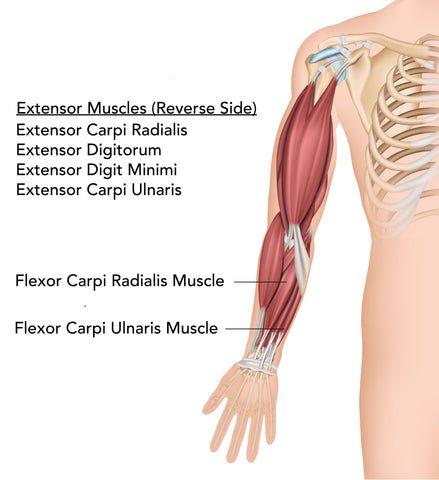Back to index

5. Arms and Legs (Other)
5.1 Forearms
Due to their constant use in almost all physical activities and movements, the forearms can become injured at home, on the job or during sports. Arm pain can be caused by a wide variety of problems ranging from joint injuries, sports injuries, overuse conditions, fractures and compressed nerves. Depending on the cause, arm pain can start suddenly or develop over time.
The Smooth Massage Ball is phenomenal at massaging the forearms. See below for the techniques to follow to help massage your flexor and extensor forearm muscles back to health.

Forearm Muscle Anatomy
5.1.1 Flexor Muscles

Forearm Flexor Muscles Massage
|
Anatomy and Function:
|
- The numerous wrist flexor muscles originate from several locations on the humerous, ulna, and radius. They insert onto the palm of the hand and underside of the fingers.
- The wrist flexors are primarily responsible for flexing and adducting the wrist.
|
|
Reasons to Treat:
|
- Due to repeated gripping activities, the wrist flexors can often become stiff.
|
|
Massage Balls to Use:
|

|
|
Set-up:
|
- Sit on a bench with a massage ball in one hand.
-
Press the massage ball against the inside of your forearm with an open palm.
- Alternatively use a table or wall instead of your other hand to extert your desired pressure on the massage ball.
|
|
Actions:
|
- With the massage ball pinned against your forearm, roll it back and forth. It may help to work in small sections as the massage ball doesn’t have a large circumference.
- Roll for 30-60 seconds and then switch arms.
- To further increase the pressure, actively extend the hand to place the wrist flexors on stretch.
|
5.1.2 Extensor Muscles

Forearm Extensor Muscles Massage
|
Anatomy and Function:
|
- The numerous wrist extensor muscles originate from several locations on the humerus, ulna, and radius. They insert across the back of the hand and fingers.
- The wrist extensors are primarily responsible for extending and abducting the wrist.
|
|
Reasons to Treat:
|
- Due to repeated typing and/or prolonged holds in an extended position, the wrist extensors can become short/stiff.
|
|
Massage Balls to Use:
|

|
|
Set-up:
|
- Sit on a bench with a massage ball in one hand.
- Press the massage ball against the outside of your forearm with an open palm.
- Alternatively use a table or wall instead of your other hand to extert your desired pressure on the massage ball.
|
|
Actions:
|
- With the massage ball pinned against your forearm, roll it back and forth. It may help to work in small sections as the massage ball doesn’t have a large circumference.
- Roll for 30-60 seconds, and then switch arms.
- To further increase the pressure, actively flex the hand to place the wrist extensors on stretch.
|
5.2 Peroneus Longus Tendon

Peroneus Longus Tendon Anatomy

Peroneus Longus Tendon Massage
|
Anatomy and Function:
|
- The peroneals originate from just below the outside of the knee and insert onto the bottom of the foot.
- Peroneus longus and brevis are responsible for plantar flexion and eversion. Peroneus tertius assists with dorsiflexion.
|
|
Reasons to Treat:
|
- Excessive tension or adhesions in the peroneals can produce lateral knee pain, or compression of the peroneal nerve which can produce numbness and/or tingling in the lower leg and foot.
|
|
Massage Balls to Use:
|
 
|
|
Set-up:
|
- Place your foot up on a low bench or chair.
- Place a massage ball along the outside of your lower leg.
|
|
Actions:
|
- From the starting position, roll the ball up and down along the outside portion of your lower leg.
- Roll for 30-60 seconds, and then switch legs
|
5.3 Tibialis Anterior Muscle

Tibialis Anterior Muscle Anatomy

Tibialis Anterior Muscle Massage
|
Anatomy and Function:
|
- The tibialis anterior originates from the lateral condyle/shaft of the tibia and inserts onto the top of the foot.
- The tibialis anterior is responsible for producing dorsiflexion and inversion of the foot.
|
|
Reasons to Treat:
|
- The tibialis anterior can often become scarred due to overuse in running and jumping activities/sports.
|
|
Massage Balls to Use:
|
 
|
|
Set-up:
|
- Place your foot up on a low bench or chair.
- Place a massage ball along the front of your lower leg.
|
|
Actions:
|
- From the starting position, roll the ball up and down along the front of your lower leg.
- Roll for 30-60 seconds, then switch legs
|
Back to index











